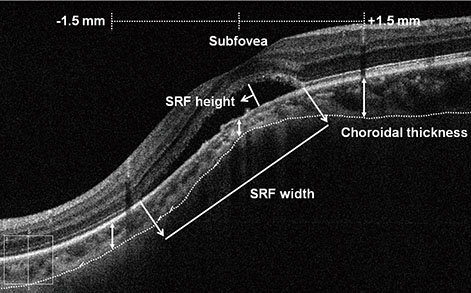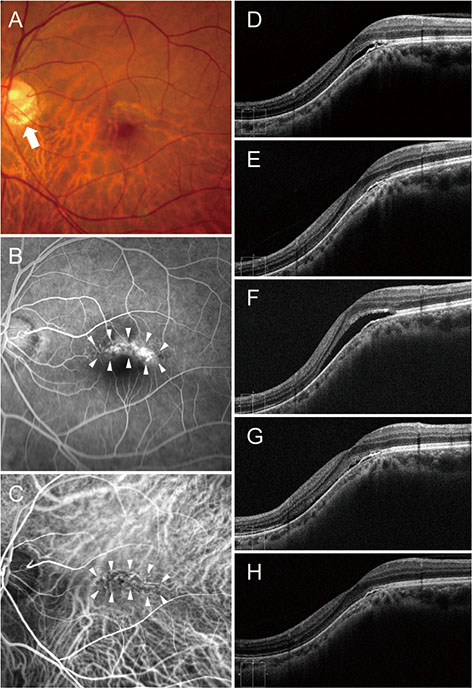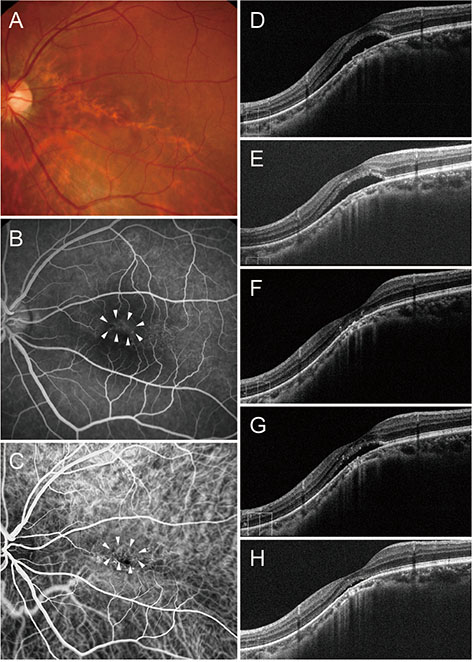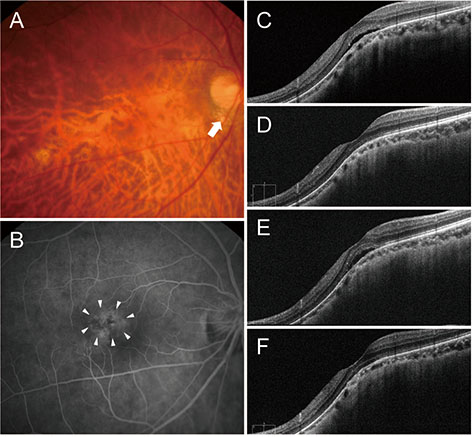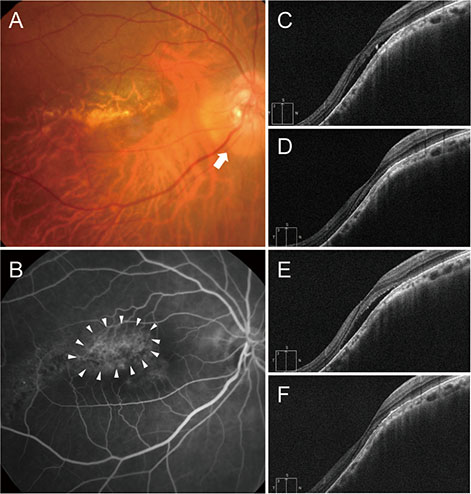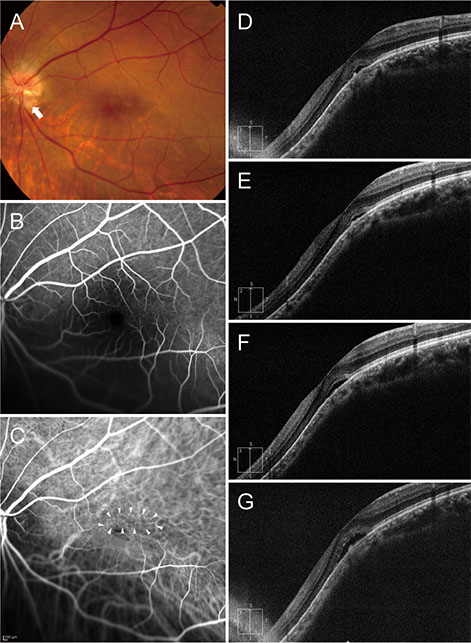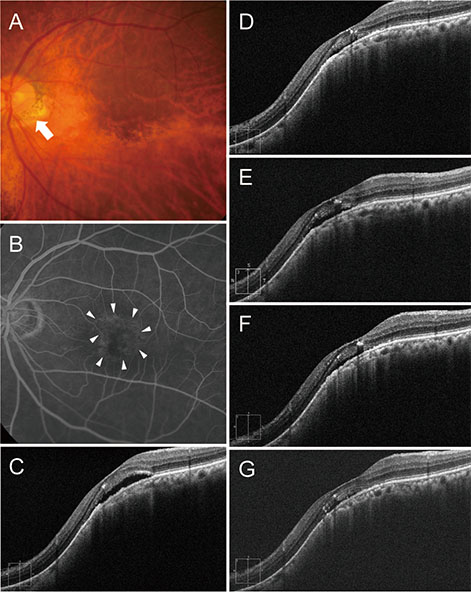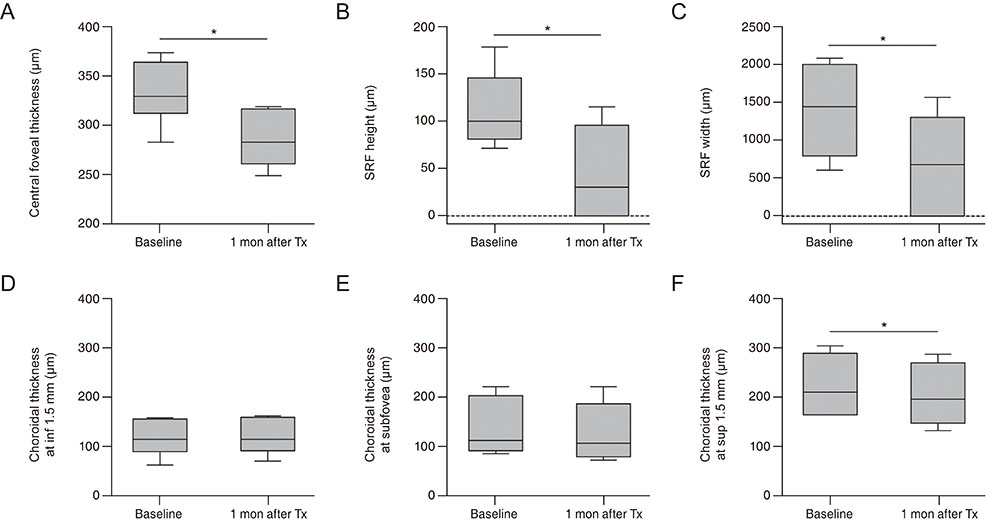Korean J Ophthalmol.
2019 Jun;33(3):228-237. 10.3341/kjo.2018.0125.
Outcomes of Anti-vascular Endothelial Growth Factor Treatment for Foveal Serous Retinal Detachment Associated with Inferior Staphyloma
- Affiliations
-
- 1Department of Ophthalmology, Jeju National University Hospital, Jeju National University School of Medicine, Jeju, Korea.
- 2Department of Ophthalmology, Seoul National University Hospital, Seoul National University College of Medicine, Seoul, Korea. hgonyu@snu.ac.kr
- KMID: 2448862
- DOI: http://doi.org/10.3341/kjo.2018.0125
Abstract
- PURPOSE
To evaluate the efficacy of anti-vascular endothelial growth factor (VEGF) treatment of eyes with foveal serous retinal detachment (SRD) associated with inferior staphyloma and to investigate choroidal thickness changes following anti-VEGF therapy.
METHODS
In this observational case series, eyes with inferior staphyloma accompanied by foveal SRD were treated with a single intravitreal anti-VEGF injection, followed by further injections as needed. Changes in height and width of subretinal fluid (SRF) and visual acuity after treatment were assessed. Choroidal thickness was measured at the subfovea, 1.5 mm superior and inferior to the fovea using enhanced depth imaging optical coherence tomography at baseline and 1 month after initial anti-VEGF therapy.
RESULTS
Six eyes from six patients were included. One month after the initial injection, the mean SRF height and width had decreased significantly from 112.5 ± 40.1 to 44.5 ± 48.7 µm (p = 0.046) and from 1,401.8 ± 627.3 to 690.7 ± 634.7 µm (p = 0.028), respectively. Mean choroidal thickness at the superior point decreased from 218.7 ± 59.3 to 200.5 ± 61.0 µm (p = 0.046). SRF resolved completely in three of the six eyes (50%) with a mean of 6.8 ± 5.9 injections (range, 1 to 15). All eyes experienced at least one recurrence of exudation, at a mean interval of 4.8 months. Mean visual acuity improvement was 0.17 logarithm of the minimum angle of resolution units at a mean of 28.7 months follow-up.
CONCLUSIONS
Anti-VEGF therapy resulted in an SRF decrease and modest visual improvement in eyes with foveal SRD associated with inferior staphyloma. Reduction in superior choroidal thickness appeared to contribute to the clinical improvements that were observed.
Keyword
MeSH Terms
Figure
Reference
-
1. Curtin BJ. The posterior staphyloma of pathologic myopia. Trans Am Ophthalmol Soc. 1977; 75:67–86.2. Apple DJ, Rabb MF, Walsh PM. Congenital anomalies of the optic disc. Surv Ophthalmol. 1982; 27:3–41.
Article3. Tosti G. Serous macular detachment and tilted disc syndrome. Ophthalmology. 1999; 106:1453–1455.
Article4. Leys AM, Cohen SY. Subretinal leakage in myopic eyes with a posterior staphyloma or tilted disk syndrome. Retina. 2002; 22:659–665.
Article5. Theodossiadis PG, Grigoropoulos V, Emfietzoglou J, Theodossiadis GP. Optical coherence tomography study of tilted optic disk associated with macular detachment. Graefes Arch Clin Exp Ophthalmol. 2006; 244:122–124.
Article6. Nakanishi H, Tsujikawa A, Gotoh N, et al. Macular complications on the border of an inferior staphyloma associated with tilted disc syndrome. Retina. 2008; 28:1493–1501.
Article7. Cohen SY, Quentel G, Guiberteau B, et al. Macular serous retinal detachment caused by subretinal leakage in tilted disc syndrome. Ophthalmology. 1998; 105:1831–1834.
Article8. Brown DM, Kaiser PK, Michels M, et al. Ranibizumab versus verteporfin for neovascular age-related macular degeneration. N Engl J Med. 2006; 355:1432–1444.
Article9. Rosenfeld PJ, Brown DM, Heier JS, et al. Ranibizumab for neovascular age-related macular degeneration. N Engl J Med. 2006; 355:1419–1431.
Article10. Ikuno Y, Sayanagi K, Soga K, et al. Intravitreal bevacizumab for choroidal neovascularization attributable to pathological myopia: one-year results. Am J Ophthalmol. 2009; 147:94–100.
Article11. Silva RM, Ruiz-Moreno JM, Rosa P, et al. Intravitreal ranibizumab for myopic choroidal neovascularization: 12-month results. Retina. 2010; 30:407–412.12. Milani P, Pece A, Pierro L, et al. Bevacizumab for macular serous neuroretinal detachment in tilted disk syndrome. J Ophthalmol. 2010; 2010:970580.
Article13. Donati MC, Miele A, Abbruzzese G, et al. Treatment of macular serous neuroretinal detachment in tilted disk syndrome: report of 3 cases. Eur J Ophthalmol. 2013; 23:267–270.
Article14. Spaide RF, Koizumi H, Pozzoni MC. Enhanced depth imaging spectral-domain optical coherence tomography. Am J Ophthalmol. 2008; 146:496–500.
Article15. Hirata M, Tsujikawa A, Matsumoto A, et al. Macular choroidal thickness and volume in normal subjects measured by swept-source optical coherence tomography. Invest Ophthalmol Vis Sci. 2011; 52:4971–4978.
Article16. Yamagishi T, Koizumi H, Yamazaki T, Kinoshita S. Choroidal thickness in inferior staphyloma associated with posterior serous retinal detachment. Retina. 2012; 32:1237–1242.
Article17. Ellabban AA, Tsujikawa A, Matsumoto A, et al. Macular choroidal thickness measured by swept source optical coherence tomography in eyes with inferior posterior staphyloma. Invest Ophthalmol Vis Sci. 2012; 53:7735–7745.
Article18. Maruko I, Iida T, Sugano Y, et al. Morphologic choroidal and scleral changes at the macula in tilted disc syndrome with staphyloma using optical coherence tomography. Invest Ophthalmol Vis Sci. 2011; 52:8763–8768.
Article19. Murakami T, Felinski EA, Antonetti DA. Occludin phosphorylation and ubiquitination regulate tight junction trafficking and vascular endothelial growth factor-induced permeability. J Biol Chem. 2009; 284:21036–21046.
Article20. Nicoletti VG, Nicoletti R, Ferrara N, et al. Diabetic patients and retinal proliferation: an evaluation of the role of vascular endothelial growth factor (VEGF). Exp Clin Endocrinol Diabetes. 2003; 111:209–214.
Article21. Saenz-de-Viteri M, Fernandez-Robredo P, Hernandez M, et al. Single- and repeated-dose toxicity study of bevacizumab, ranibizumab, and aflibercept in ARPE-19 cells under normal and oxidative stress conditions. Biochem Pharmacol. 2016; 103:129–139.
Article22. Hirano Y, Yasukawa T, Tsukada A, et al. Resolution of exudative changes refractory to ranibizumab after aflibercept injections at the margin of inferior staphyloma in tilted disc syndrome. Ophthalmic Surg Lasers Imaging Retina. 2015; 46:384–386.
Article
- Full Text Links
- Actions
-
Cited
- CITED
-
- Close
- Share
- Similar articles
-
- A Case of Retinal Detachment with Equatorial Scleral Staphyloma
- A Case of Retinal Detachment with Equatorial Scleral Staphyloma
- A Case of Polypoidal Choroidal Vasculopathy and Serous Retinal Detachment in a Bilateral Dome-shaped Macula
- Review and update for central serous chorioretinopathy
- Anti-Vascular Endothelial Growth Factor Therapy for Choroidal Neovascularization Secondary to Optic Nerve Head Drusen

